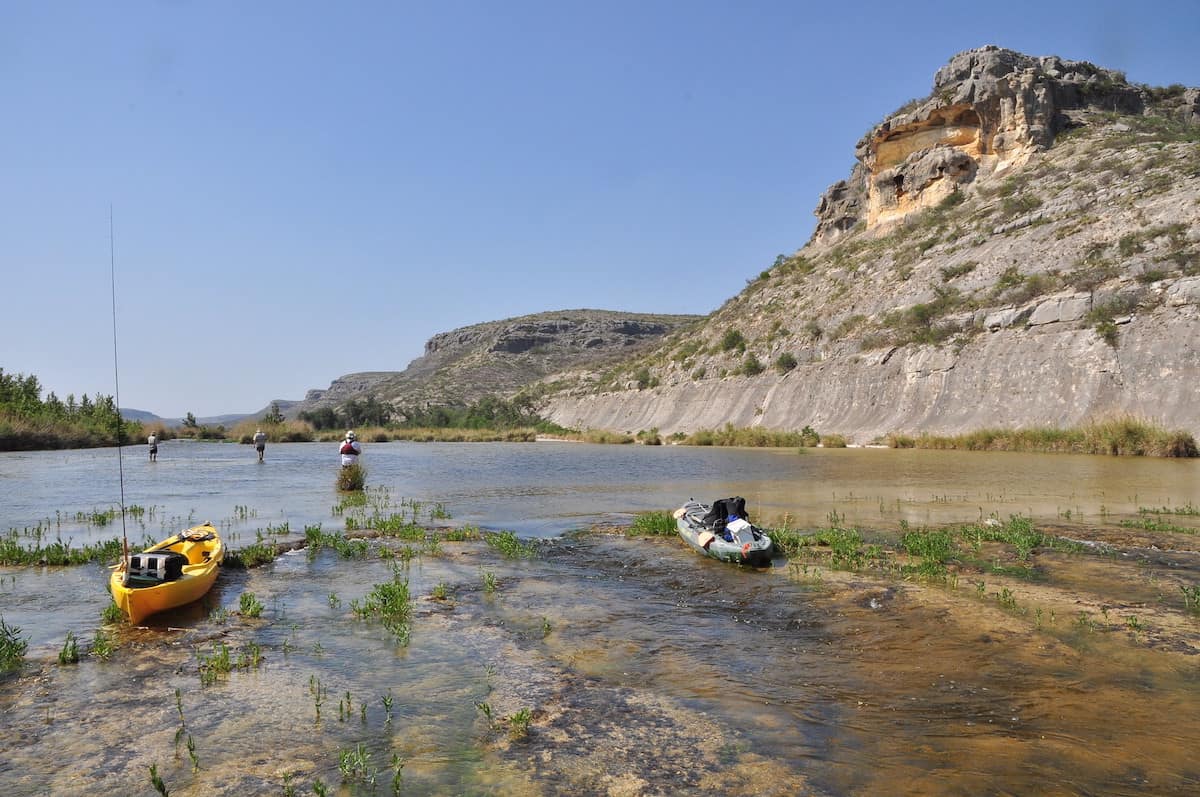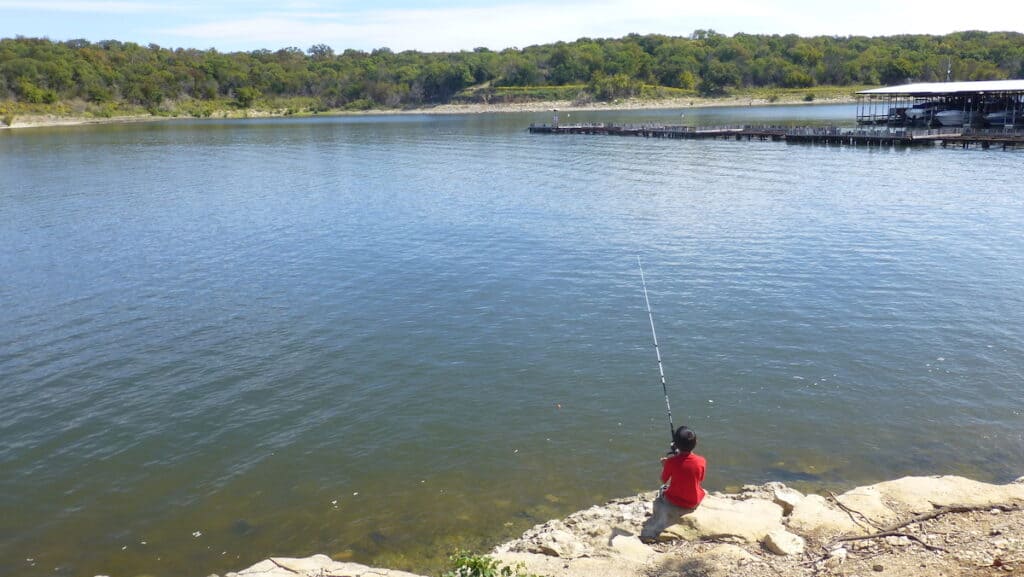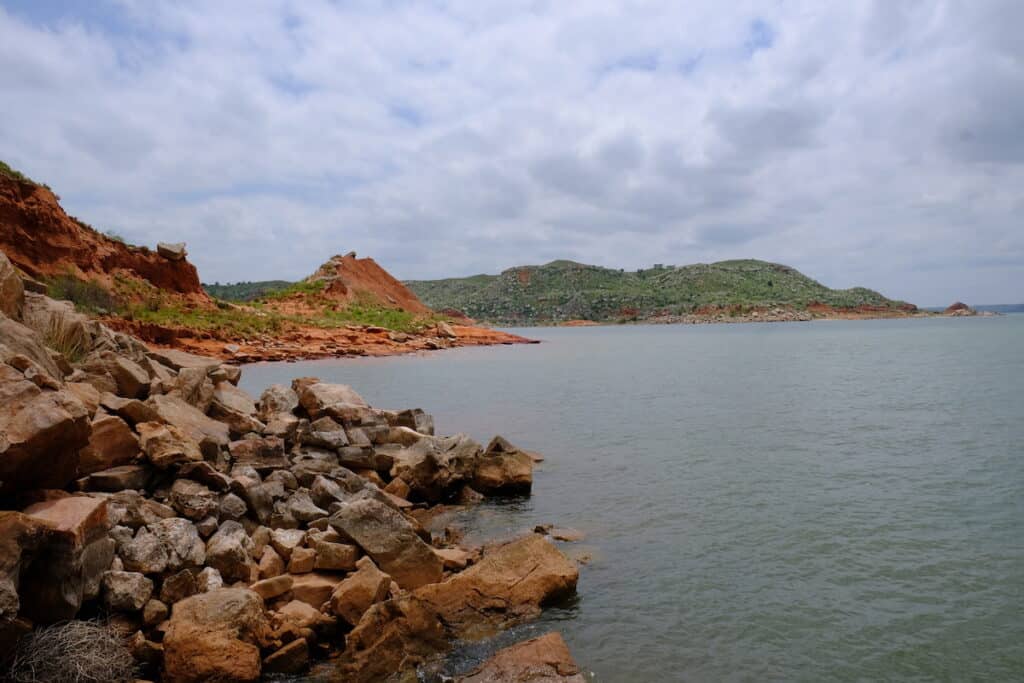When it comes to fishing, Texas is probably best known for largemouth bass. Smallmouths are generally more at home farther north, in places like the Great Lakes and upper Mississippi River basin.
But Texas is also home to some surprising smallmouth bass fishing hot spots. Several deep, clear man-made reservoirs in the Lone Star state have gained a reputation for kicking out massive bronzebacks.
The best smallmouth bass fishing in Texas tends to be in spring and fall. Smallmouths spawn between March and May in various parts of the state, and the best fishing tends to be when water temperatures are right around 60 degrees.
The best smallmouth lures are usually tube jigs, crankbaits and soft jerkbaits. Drop-shot-rigged soft plastics are great for fishing deep structure, and topwaters often draw strikes in the morning and evening.
Smallmouths favor cooler temperatures than largemouths, and they prefer clearer water and rocky habitat. That somewhat narrows down the habitat options for smallies in Texas, but a handful of lakes offer just what smallmouth bass need to thrive.
What follows are our picks, including three outstanding smallmouth bass fisheries and another five lakes and a river section where you also can catch these-hard fishing fish.
Lake Texoma
Straddling the line between Texas and Oklahoma, Lake Texoma is a vast, 74,000-acre reservoir on the Red River.
Texoma is simply one of the most diverse fisheries in the state, and a rare lake in Texas where smallmouth bass fishing is often even better than largemouth fishing.
Lake Texoma hosts a lot of bass tournaments, and winning bags here often contain a mix of largemouths and smallmouths. Smallmouths weighing 4 pounds are more common here than anywhere else in Texas.
With so much water to cover, it’s helpful to narrow down your search area. Lake Texoma has everything from weed beds and standing timber to rocky bluffs and channel edges.
Most of the best smallmouth habitat is in the lower, eastern end of the lake. There are some very steep bluff walls in this area that plunge down into picture-perfect smallmouth water.
The very best action is westward from the Denison Dam along the steep, rocky shoreline to Eisenhower State Park.
Crankbaits and jigs are classic smallmouth lures that usually work well here.
However, when the bite is tough, live bait rarely fails. Some local anglers use live shad along the rip-rap dam to tempt smallmouths throughout spring, summer and fall.
In spring, smallmouths spawn in gravel-bottomed areas when the water temperature is around 60 degrees. Look for shallow gravel areas with some protection from the wind.
Sand is another bottom type to watch for in this part of the lake. There are quite a few spots where a sandy, beach-like area will drop off quickly to an area with a mix of sand and rocks.
Smallmouths love areas like this, and if you can find a spot where sand and rocks drop several feet in a short distance, you’ve almost certainly found a good smallmouth spot. Try tossing a soft jerkbait or tube jig along the drop.
Lake Texoma has many great fisheries beyond smallmouth bass, including stripers and catfish.
More: Lake Texoma Fishing
Lake Whitney
Lake Whitney was once the king of Texas smallmouth lakes. Eight of the 10 biggest smallmouths ever caught in Texas came from Lake Whitney, all during the 1980s and ‘90s.
Suffice to say, this 23,500-acre Brazos River reservoir isn’t what it once was. But smallmouth numbers have been improving in recent years after the fishery tanked around the turn of the century a couple decades back.
These days, the section of the Brazos river below Lake Whitney may be more exciting than the lake itself.
The middle and lower sections of Lake Whitney are the best parts of the reservoir for smallmouths. There’s quite a bit of rocky habitat here, and the water tends to be a lot clearer than up at the north end of the lake.
Look for smallmouths in rocky coves and the backs of feeder creeks toward the lower end of Lake Whitney in springtime.
The smallmouth fishing slows down in summer, but you can still catch them on diving crankbaits and drop-shot rigs around deep points and drop-offs.
Lake Whitney also sees a great fall smallmouth bite as the water cools back down. From October to December, try shallow, rocky areas with crawfish-colored crankbaits.
As with Texoma, Lake Whitney also is among the best striped bass fishing lakes in Texas.
Brazos River
As mentioned, the Brazos River itself can at times out-fish Lake Whitney when it comes to smallmouth bass.
The section of the Brazos below the Whitney Dam has also given up some big smallmouths in recent years, and Texas Parks & Wildlife has stocked smallmouths in the river repeatedly. There’s also evidence that smallies are reproducing naturally.
Tube jigs, soft jerkbaits and downsized minnow plugs are great lures for pulling smallmouths from deep pools, current breaks and riffles in the river.
The spillway right under the dam is one of the best spots. The U.S. Army Corps of Engineers operates several parks with access both above and below the dam.
Belton Lake
Almost certainly the best smallmouth lake in Central Texas, Belton Lake spans a little over 12,000 acres just west of Temple. It’s a man-made reservoir on the Leon River, and in this part of the state, it’s smallmouth central.
Smallmouth bass have been consistently stocked in Belton Lake for decades, and have developed a healthy population that includes a ton of keeper-size bass weighing 2 or 3 pounds, as well as a few giants weighing upwards of 5 pounds.
Belton Lake is a long, meandering reservoir. As is often the case, smallmouths favor the lower end of the lake, where the water is clearest and the habitat is more suitable.
Long, rocky points, steep drop-offs and rocky bluffs along the bank are just the kinds of places where smallmouths thrive. Most smallmouths are caught from the dam up to around the Cedar Creek area.
Belton Lake is a lot of fun for anglers who enjoy working bottom structure with jigs, tubes and soft plastics. There are steep rocky areas on either side of the dam where smallmouths are known to smack crankbaits and spinners in about 5 feet of water.
The best fishing is in spring and fall when water temperatures are in the upper 50s and lower 60s.
During the spring spawn, look for smallmouths in rocky coves that are protected from the chilly north wind. Smallmouths might be right up against the bank in spring, but in summer they usually transition deeper along rocky, sloping points.
Belton Lake is managed by the U.S. Army Corps of Engineers, which operates several parks around the shoreline. Live Oak Ridge Park is a good place to launch toward the lower end of the lake.
Thanks in large part to the smallmouth fishing, Belton Lake rates among the best bass fishing lakes near Austin.
Honorable Mentions
Texas has a few additional waterways that are well worth checking out for smallmouth bass.
While these spots aren’t quite the safe bets the lakes mentioned above are, they’ve still given up some serious smallmouths over the years.
Stillhouse Hollow Reservoir
A short drive north of Austin, 6,400-acre Stillhouse Hollow Reservoir is a deep, clear reservoir at the edge of the Texas Hill Country. It’s been stocked several times with smallmouth bass, including 53,330 smallmouth fingerlings in 2018.
Stillhouse Hollow is definitely one of the best smallmouth fisheries in Central Texas, though it does tend to get overshadowed by Belton Lake, which is just a few miles away.
Stillhouse Hollow Reservoir has a lot of classic smallmouth habitat, and the lake record is over 6 pounds.
Because of its very clear water, bass often spook easily, and finesse techniques are usually most effective. Try drop-shotting along deep, rocky points. The rip-rap along the dam can be productive too.
There’s also a great topwater bite on Stillhouse Hollow, especially on summer mornings and evenings.
Expect a mixed bag of smallmouths and largemouths most days, but largemouth bass are more common in the upper lake, where there’s more weed growth and timber.
The U.S. Army Corps of Engineers-operated Stillhouse Park provides boat and bank access near the dam.
The section of the Lampasas River right below the Stillhouse Hollow Dam can also be productive, and is accessible by foot along a series of walking trails in Chalk Ridge Falls Park.
Grapevine Lake
Located right in the midst of the sprawling Dallas-Fort Worth Metroplex, 6,700-acre Grapevine Lake is one of North Texas’ great urban fisheries. Largemouths, smallmouths and spotted bass are all present, making this one of the DFW area’s best bass fishing lakes.
Smallmouth bass have always been secondary to largemouths here, but Texas Parks & Wildlife has been stocking fingerling smallmouths heavily since 2008 in an effort to improve the fishery. Those efforts seem to be paying off, and catches of bronzebacks have definitely seen an uptick in recent years.
The water in Grapevine Lake tends to be somewhat stained. Smallmouths, usually favoring clearer water, are most common in the lower end of the lake where the clarity is a little better. The area closest to the dam is a good place to start.
The lower lake also has several stretches of boulder-strewn banks, which are usually good places to pick off a few smallies.
Tube jigs and crankbaits are effective, and wacky worms often draw strikes when bass are a little more finicky.
Katie’s Woods Park is a good access point on the southern shore of Grapevine Lake, not too far from the dam. The banks here consist of craggy sandstone cliffs and rocky coves, which are frequented by smallmouth bass.
Grapevine Lake also happens to be one of the best places to catch catfish near Dallas and Fort Worth.
Devil’s River
A crystal-clear stream that feeds Amistad Reservoir in West Texas, the Devil’s River offers a truly unique fishing experience. With its cool, spring-fed waters and excellent clarity, it’s filled with prime smallmouth habitat.
The fact that the Devil’s River is surrounded by ruggedly beautiful desert scenery is icing on the cake.
The river is, for the most part, slow moving and placid, making it a very good place to fish from a kayak. There are a few minor rapids and at least one waterfall to watch out for.
Due to the clear water and close quarters, finesse fishing tactics work best. Downsize everything. Finesse jigs and small crankbaits on medium-light tackle catch more smallmouths than anything else, and fly-fishing is also an option.
But be ready for a fight. Smallmouths that grow up in moving water are some of the strongest fish you’ll ever tangle with, and even a 2- or 3-pound smallie—about the typical size here—is more than capable of breaking 8-pound line.
Look for smallmouths in deep pools close to the bank, below boulders that break the current, and anywhere a shallow riffle spills down into a deeper hole. Access is available through Devil’s River State Natural Area.
Canyon Lake
Spanning about 8,300 acres, Canyon Lake is a man-made reservoir on the Guadalupe River. The lake is located just outside New Braunfels, and its steep, rocky banks offer prime smallmouth habitat. Vegetation is almost completely absent.
Largemouth bass are the dominant black bass species in Canyon Lake, and Texas Parks & Wildlife suspended smallmouth stocking in the 1980s, but a significant, self-sustaining smallmouth bass population is still going strong.
Most smallmouths are caught in the lower third of the reservoir, closer to the dam. The water is typically quite clear in this part of the lake, and the bottom structure is dominated by rocky ledges, reefs and drop-offs.
Try running a crankbait or working a jig along the rip-rap face of the dam when smallmouths are in shallow water, or head to the nearest drop-off in summer and ply the bottom with a drop-shot rig.
Smallies don’t usually get huge here, but there are solid numbers of 2- and 3-pound fish, and 5-pounders have been reported.
The U.S. Army Corps of Engineers operates several access points around the lake, including North Park and Overlook Park on the lower lake near the dam.
The lake also harbors some Guadalupe bass, although the Guadalupe River is a better place to specifically target this smaller but spunky Texas state fish.
The lake itself is among the best in Texas for white bass fishing, as is the river above it during the spring run.
Lake Meredith
A great Texas Panhandle reservoir spanning over 16,000 acres, Lake Meredith has been recovering in recent years from a series of algae blooms that devastated smallmouth populations.
It would be a stretch to say the lake is as good as it was in its glory years—the 7.93-pound state record smallmouth was caught here in 1998—but a gradual comeback is well underway.
Good-sized smallies are once again being caught along the lake’s steep, rocky banks.
Vegetation is limited in Lake Meredith, and smallmouths typically stick close to rock piles and ledges in the lower half of the reservoir, where the water is clearest.
The best bite is in spring when temperatures are around 60 degrees and bass come in close to the rocky shorelines.
Lake Meredith National Recreation Area completely surrounds the lake and provides multiple boat launch sites. There are several good bank fishing areas toward the northern end of the lake near the dam.
Lake Meredith is also notable for being one of the only reliable walleye lakes in Texas. It’s not uncommon to catch both walleye and smallmouths on live minnows and worms in springtime along shoreline outcropping and drop-offs in about 15 feet of water.



